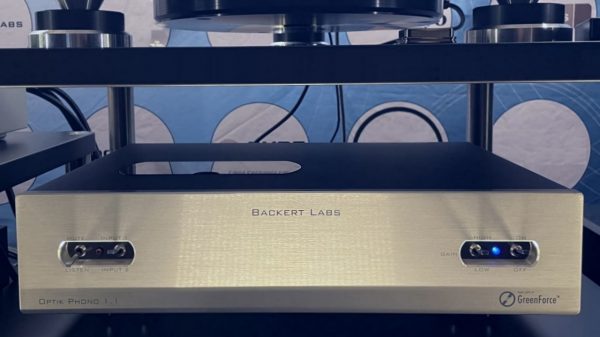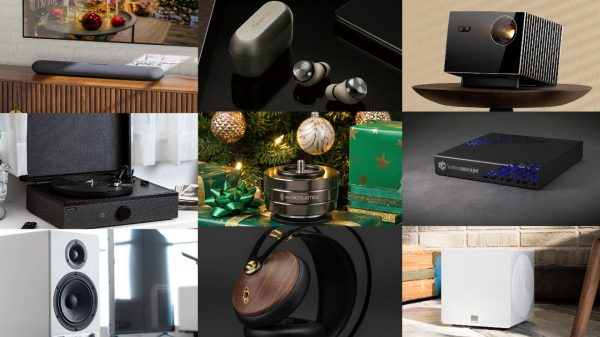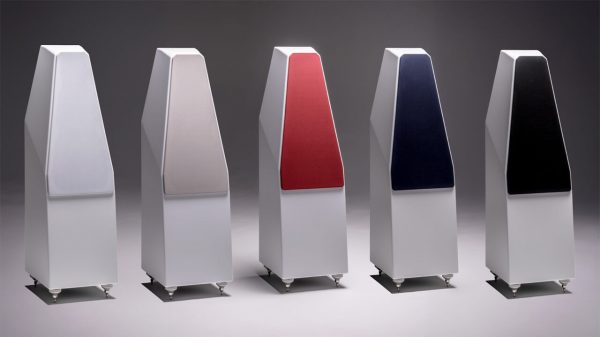Wilson Audio has just introduced the Sasha W/P Series-2 floorstanding two cabinet loudspeaker for serious audiophiles who can afford a $30K price tag. The new speakers offer precise time alignment, so critical to harmonic expression, dynamic alacrity, and musicality. In addition, the Wilson Convergent Synergy Tweeter, which transformed the sound of the Alexandria XLF, has now been modified for Sasha’s two cabinet configuration.
Sasha, like the WATT/Puppy before it, remains Wilson’s best selling speaker. Its combination of high performance in a relatively compact form factor has always been its greatest strength, and now the performance side of that equation has risen to an entirely new plane.

Woofer Enclosure
A new Sasha woofer enclosure was developed using Wilson’s laser vibrometer. The engineers were able to reduce the velocity of micro synthetic resonances by 27.5%. In laymen’s terms, this means a nearly 30% reduction in (already vanishingly low) cabinet resonances. The Sasha Series-2 woofer enclosure resides at the zenith of what is currently possible.
Custom Version of the Convergent Synergy Tweeter
The magic of Wilson’s midrange driver is in no small part due to its ability to cover almost the entire mid-band without interruption of the crossover, including in the male-vocal region. The Wilson mid is unsurpassed for its harmonic coherence and dynamic alacrity. But it also means that the driver is large and therefore limited in its upper frequency range. The previous Sasha featured an inverted titanium dome tweeter that proved a successful and coherent match to Wilson’s midrange driver. During its decade-long development, it evolved such that it uniquely excelled in the areas of low distortion, resolution of micro and macro dynamics, and harmonic expression. It was developed to play down to the one kilohertz region with low distortion and high power handling ability.


Four years ago, the Wilson design team led by Dave began a renewed quest for an improved tweeter that culminated in a proprietary Wilson design, which was dubbed the Convergent Synergy Tweeter. The new Wilson CST first found a home in the Alexandria XLF. Wilson’s tweeter rejects exotic materials in favor of a new silk dome design that better meets all of Wilson Audio’s musical design goals—and, perhaps most importantly, provides a seamless match to Wilson’s midrange driver.
 The Convergent Synergy Tweeter now makes its debut in the Sasha. This version of the CST features a bespoke rear-wave chamber, designed specifically for the Sasha Series-2 platform.
The Convergent Synergy Tweeter now makes its debut in the Sasha. This version of the CST features a bespoke rear-wave chamber, designed specifically for the Sasha Series-2 platform.
Midrange/Tweeter Enclosure
Wilson’s Convergent Synergy Tweeter’s axis response requires a different geometry than did the Focal tweeter used in the previous model. The two-plane baffle of the Sasha Series-2’s upper module optimizes the axis response angles of both the Wilson Audio midrange driver and the CST individually.
The tweeter portion of the baffle is now made from the latest generation of X-Material, like in the Alexia. The midrange portion of the baffle continues to be S-material. S-material was developed specifically for use in midrange baffles, and is a wonder of midrange beauty and low-resonance. In combination with X-material, S-material reduces measurable and audible noise and coloration in the midrange.
Rigidity and resonance control are further enhanced via a new bracing strategy and the redistribution of the two composites. The Series-2 now also employs separate tweeter and midrange grills, each geometrically designed to lessen frame-induced diffraction.

Radically Enhanced Time Domain Performance
The original Sasha facilitated group delay via four different spike lengths. The Series-2 features an Alexia type alignment block with more than twenty settings. This refinement radically increases the accurate alignment of the Sasha drivers in the time domain. Adjustable driver propagation, the precision of which is completely unique to Wilson loudspeakers, results in greater transient accuracy, tonal beauty, spatial retrieval, and musicality.
The exact location of the upper module is based on the specific geometry of each room and the location and seated height of the listener. The position of the upper module is precisely specified in the provided owner’s manual.


Crossover
All crossover component values have been fine-tuned and optimized for the new design and to account for the addition of the CS tweeter.
Price and Availability
Wilson Audio’s Sasha Series-2 will sell for $29,900. First shipments for existing orders are scheduled for late February 2014. Please place orders for demo and sell-through needs as soon as possible to reserve your shipment position. The orders will be filled and shipped on a first-come, first-served basis. Demo orders will be the first priority so all of Wilson’s dealers and distributors can begin showing the Sasha Series-2. Customer sell-through orders will be scheduled after demo orders have been filled. Check with Jerron Marchant for specific ship dates for your order.


 Specifications:
Specifications:
Drivers:
- Woofer: 2– 8 inch drivers (20.32 cm)
- Midrange: 7 inches (17.78 cm) Cone Material: Cellulose/Paper Pulp Composite
- Tweeter: 1 inch, Dome (2.54 cm) Material: Doped Silk Fabric
Dimensions:
- Height – 45 to 47-inches (111.76—119.38 cm)
- Width – 14 inches (35.56 cm)
- Depth – 21.25 inches (53.91 cm)
Modules:
- Enclosure Type Woofer: (Rear Ported) X-Material
- Enclosure Type Midrange/Tweeter (Rear vented) X- and S-material
 History of Wilson Audio’s WATT/Puppy
History of Wilson Audio’s WATT/Puppy
In the high-end, it often seems that loudspeaker development is more the result of the capricious whims of undisciplined and fickle designers than the meaningful fruit of scientific research. In direct contrast to his competitors, Dave Wilson has always believed in doing the science right at the outset, and then building on that solid platform as technology and research allows. The science of accurate music reproduction has been Dave’s life work.
The WATT/Puppy is perhaps the most salient and iconic example of Dave Wilson’s lifelong quest for the absolute sound. The WATT/Puppy’s place in history is well established; it is perhaps the most influential loudspeaker of the modern era. The WATT, the upper portion of the combination, began as a utilitarian recording tool, a portable location monitor for the recordings he was then making. He knew that even the smallest changes in microphone placement made the difference between a merely good recording and one that possessed the realism for which he strived. Dave needed a small loudspeaker that could accurately reveal these differences. Early on it became clear to Dave that none of the commercially available loudspeakers were adequate to the task. The idea for the WATT was born. The WATT was by no means Dave’s first effort in loudspeaker design; it benefited from lessons learned from years of research and trial-and-error experimentation. He already had the legendary WAMM under his belt, itself an unprecedentedly ambitious and groundbreaking assault on the state of the art.
 Dubious of the market viability of an expensive, limited-range mini monitor, Dave was reluctant to make the WATT available for purchase to the general public. It is one of those rare instances where the purity of a designer’s vision was completely bereft of cynical market analysis. It was only at the suggestion (which in some cases was more like insistence) of audio-dealer friends that he offered the WATT for sale to the general audiophile public.
Dubious of the market viability of an expensive, limited-range mini monitor, Dave was reluctant to make the WATT available for purchase to the general public. It is one of those rare instances where the purity of a designer’s vision was completely bereft of cynical market analysis. It was only at the suggestion (which in some cases was more like insistence) of audio-dealer friends that he offered the WATT for sale to the general audiophile public.
Despite Dave’s skepticism, demand for the WATT multiplied. He designed a solid stand on which the WATT could sit at the ideal height, and the Gibraltar was born. Later, Dave reasoned that the same space occupied by the Gibraltar could instead house a woofer cabinet, and the Puppy was born.
The marriage of the WATT with the Puppy, the WATT/Puppy, changed the way the audiophile community perceived high-end loudspeakers. Compared to the four tower behemoths that dominated the product category of that day, the diminutive WATT/Puppy was a revelation. Its outsized dynamic and spatial presentation defied what the eye told the brain to expect. The WATT/Puppy was intrinsically simple; it gave its owners a great deal of musical pleasure, but demanded relatively little in return. It did not require bi-amping—or even biwiring—eschewing unnecessary complexity for a fundamentally correct design, executed at an unparalleled Olympian standard.
 The audiophile community was smitten, and the WATT/Puppy was an overnight success. Over the next two decades, the WATT/Puppy became the largest selling loudspeaker in its price range in history.
The audiophile community was smitten, and the WATT/Puppy was an overnight success. Over the next two decades, the WATT/Puppy became the largest selling loudspeaker in its price range in history.
A Masterpiece Enhanced
The eighties soon gave way to the nineties. Dave led his nascent design team in the development of a new generation of enclosure materials. Rich, automotive-grade paint replaced wood side panels. A system of spikes allowed time alignment of the drivers for different listening distances. Developments in drivers, crossovers, and construction techniques made each successive WATT/Puppy more musical, more dynamic, and more transparent.
With the advent of Sasha W/P, Dave and his team re-imagined the platform as a unified system. The discrete nature of the separate WATT (which remained a stand-alone loudspeaker distinct from the Puppy with its own dedicated crossover) was abandoned. Instead, the Sasha was redesigned from the ground up as an integrated system, allowing Wilson to optimize every detail to achieve the next quantum leap in compact loudspeaker performance.

































